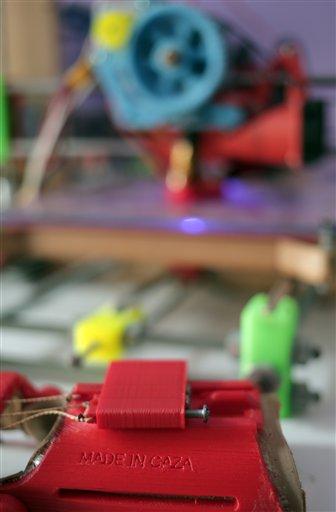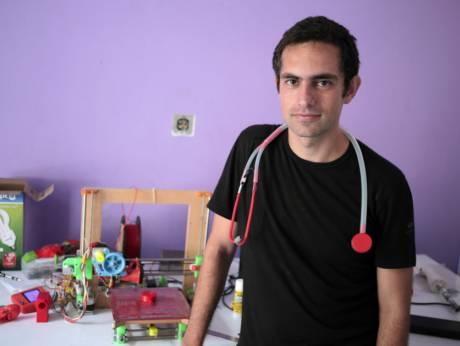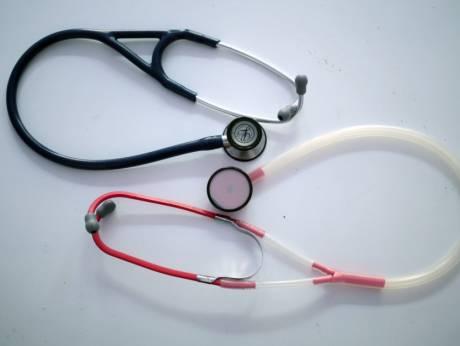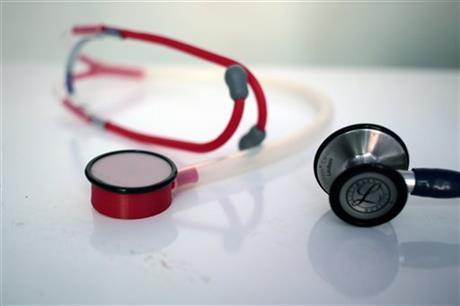Last month, we covered news of Dr. Tarek Loubani’s Glia Project, which seeks to bring 3D printed medical equipment to the areas that need it most–starting with the much-beleaguered Gaza Strip. The incredible stethoscope he developed is able to be created at extreme cost savings and in a fraction of standard production time thanks to 3D printing technology.
This past week, the Palestinian-Canadian doctor was in Gaza and able to see the creation process in action as his team printed a stethoscope out at a Gaza City store.
One of the benefits of 3D printing technology, as we’re seeing more and more frequently, is its ability to create necessary objects on-demand and on-site for areas that need them most. The 3D printer in Gaza was itself assembled locally, and Dr. Loubani was able to connect the 3D printed components together, all printed in red filament, attaching the head, ear tubes, and ear tips together.
“I’m very happy that patients in Gaza and patients all around the world can now, with these stethoscopes, receive the best care possible,” Dr. Loubani said.
The open source stethoscope has also proven to be not only as effective as the Littmann Cardiology III model that currently leads the market, but is perhaps even superior. Dr. Jonathan Dreyer, who is not involved in the Glia Project, is the research director of emergency medicine at the University of Western Ontario’s Schulich School of Medicine and Dentistry, and has noted that this 3D printed stethoscope is “as good or better” than the Littmann Cardiology III device.
“The Glia model stethoscope is indeed a high quality instrument,” said Dr. Dreyer. “I have used it on many of my patients in the emergency department and can attest to the fidelity of the sound.”
While the project was initially inspired by Dr. Loubani’s 2012 stint at Gaza City’s main hospital, Shifa, during an eight-day Israeli/Palestinian war, during which doctors had access to only two stethoscopes, the London, Ontario-based emergency medicine doctor has also learned that these tools are not frequently used in the area. Through his low-cost tools and the ease with which they are able to be made locally, Dr. Loubani hopes to introduce more stethoscopes to doctors in not only the Gaza Strip, but also to other impoverished nations.
“This is simple, cheap and it’s enough for us here. Now we can make a stethoscope available for each doctor,” said Shifa’s head of emergency department,” Dr. Ayman Sahbani, who tested the 3D printed stethoscope.
 The Gaza Strip has faced an eight-year blockade, which impacts the importation of all goods including medical supplies, which has led to shortages of medical consumables, supplies, medicines, and IV bags. This shortages, says Dr. Loubani, “is something that I think we can translate from a big problem to a big win for us in Gaza.” Through on-site production processes, 3D printing enables each hospital to print the supplies it needs–and the Glai Project will ultimately create additional medical devices.
The Gaza Strip has faced an eight-year blockade, which impacts the importation of all goods including medical supplies, which has led to shortages of medical consumables, supplies, medicines, and IV bags. This shortages, says Dr. Loubani, “is something that I think we can translate from a big problem to a big win for us in Gaza.” Through on-site production processes, 3D printing enables each hospital to print the supplies it needs–and the Glai Project will ultimately create additional medical devices.
Dr. Loubani has stated that he intends to “produce these devices locally so they meet local need and so that they are not dependent on the political winds of the Israelis and of the donor community.” Among the other devices the Glia Project hopes to make available are needle drivers and pulse oximeters. Surgeons use needle drivers to hold suturing needles, while pulse oximters measure blood oxygen levels–and both could be created on-site, on-demand with low cost to hospitals.
As far as materials go, Dr. Loubani is well aware that his options are limited by both cost and the end products’ uses in medicine, where materials must be safe for use from both a sterility and an allergic concern standpoint.
“A few plastics come to mind,” he said in an interview with Slashdot last month. “ABS is FDA approved, as is Nylon 680 and some PETT. For now, underserviced populations will not be able to receive 3D printed metals – it’s too costly and out of scope.”
For his own part, Dr. Loubani is aware of his own limitations, and of the realities of 3D printing and the ultimate impact he can have. His ultimate message, though, certainly belies the real truth of the maker movement as it concerns humanitarianism: “why not me?”
“You’re right – there is nothing special here,” he told Slashdot, “and I embrace my mediocrity as a doctor and geek. Somebody just had to do a bit of work and spend a bit of money. I don’t consider myself to be from some ‘land far away’: I am Palestinian and lived as a stateless refugee the first 13 years of my life in Kuwait where I was born, and then in Canada. However, I now have the luxury of a Canadian passport, a first-world academic post at the Division of Emergency Medicine in London, Canada, and the ability to connect two disparate worlds.
When I saw the problem while trying to treat wounded patients in the 2012 war in Gaza, I didn’t ask myself ‘why not somebody else?’ I asked: ‘why not me?’”
You can see the open source files for these medical devices at the Glia Free Medical Hardware project site on GitHub. Discuss this story in the Gaza Medical Printing forum thread on 3DPB.com
[All photos: AP]
In this Monday, Sept. 7, 2015 photo, the 3D printer used to manufacture stethoscopes by Dr. Tarek Loubani, a Palestinian-Canadian doctor, is seen in Gaza City. To combat a medical supply shortage in the beleaguered Gaza Strip, a Palestinian-Canadian doctor is manufacturing stethoscopes with a 3-D printer _ and doctors say they work as well as the originals. (AP Photo/Khalil Hamra)
Subscribe to Our Email Newsletter
Stay up-to-date on all the latest news from the 3D printing industry and receive information and offers from third party vendors.
You May Also Like
3D Printing News Briefs, April 13, 2024: Robotics, Orthotics, & Hypersonics
In 3D Printing News Briefs today, we’re focusing first on robotics, as Carnegie Mellon University’s new Robotics Innovation Center will house several community outreach programs, and Ugogo3D is now working...
Rail Giant Alstom Saves $15M with 3D Printing Automation Software 3D Spark
3D Spark has entered into a three-year deal with the rail giant Alstom. Alstom, a transport behemoth with annual revenues of $16 billion, specializes in the manufacture of trains, trams,...
Meltio Expands Global Reach with New Partnerships in the Americas and Europe
Spanish 3D printing manufacturer Meltio has expanded its sales network across the globe. With the addition of three new partners in the United States, Brazil, Argentina, and Italy, Meltio aims...
3D Printing Webinar and Event Roundup: April 7, 2024
Webinars and events in the 3D printing industry are picking back up this week! Sea-Air-Space is coming to Maryland, and SAE International is sponsoring a 3D Systems webinar about 3D...



































